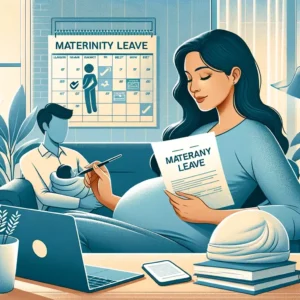Introduction
Divorce is a difficult decision to make, and the process of getting one can be stressful. However, if both spouses are in agreement and committed to going through with the process, it can be made easier by understanding the legal dynamics of divorce in India. This article helps you understand how to get a divorce in India, what paperwork is required, and other aspects of the process. Either Contested divorce or Mutual Divorce – this article covers all angles of getting a divorce in India. Before proceeding with the main article main concepts are explained:- What is divorce, What are the reasons for Divorce, What are types of divorce, and finally How to get a divorce in India. Read on to find out more.
What is Divorce?
Reasons for Divorce
In India, divorce is not something that is considered to be the last resort. It is seen as an opportunity to start fresh and move on from a failed marriage. There are many reasons why couples may choose to divorce, such as infidelity, financial problems, or simply incompatible lifestyles.
Some common reasons for divorce include:
- Infidelity: When one spouse has an affair, it can be a major source of strain on the relationship and may lead to the breakdown of the marriage.
- Lack of communication: If a couple is unable to effectively communicate and resolve conflicts, it can lead to resentment and a breakdown of the relationship.
- Differences in values: When a couple has different values and goals for their future, it can be difficult for them to see eye to eye which may lead to the end of the marriage.
- Differences in expectations: If one spouse has different expectations for the relationship than the other, it can lead to misunderstandings and disappointment.
- Growing apart: Sometimes, couples simply grow apart and no longer have the same connection they once had.
- Stress: Stress from external sources, such as work or financial problems, can put a strain on a relationship and may lead to divorce.
- Physical or emotional abuse: If one spouse is abusive towards the other, it is often not possible to repair the relationship and divorce may be the only option.
It is important to note that every couple is different and the reasons for their divorce may be unique to their relationship.
Types of Divorce in India
There are two types of divorce in India- contested and uncontested. In a contested divorce, the husband and wife cannot agree on one or more aspects of the divorce, such as property division, child custody, or alimony. In an uncontested divorce, the husband and wife have agreed on all aspects of the divorce prior to filing.
If you are considering a divorce in India, it is important to understand the difference between these two types of divorce. A contested divorce can be much more complicated and expensive than an uncontested divorce. If you and your spouse are unable to agree on all aspects of your divorce, it is important to speak with a lawyer to help you navigate the process.
In addition to these types of divorce, India also recognizes divorce through the Special Marriage Act (1954), which allows couples of any religion to seek divorce under a uniform set of laws.
How To Get Divorce In India
The Divorce Procedure in India:
The process of getting divorced in India can be complicated and often requires the help of a lawyer. Couples must first file for divorce in the district court where they live. They will then need to appear before a judge to have their divorce finalized.
During the divorce proceedings, couples will need to decide how they will divide their assets and custody of their children if they have any. Once the judge has made a decision, the couple’s divorce will be official and they will be able to move on with their lives.
The procedure for Contested Divorce and Mutual Divorce is different so firstly I have explained about contested divorce procedure and the mutual divorce procedure.
Contested Divorce Procedure in India:
- Filling of Contested Divorce Petition and Service of Summons:- The first step in getting a divorce in India is to file a petition with the court. The petition must state the grounds for divorce, which can include adultery, desertion, mental cruelty, or physical cruelty. Once the petition is filed, it must be served on the other party to the marriage.
- Response:- The spouse against whom the divorce is filed must appear in court on the specified date after receiving the summons. If the other spouse doesn’t show up on the scheduled date, the judge may let the petitioner have an ex-parte hearing; following that, the court issues an ex-parte order of divorce to end the divorce process.
- The beginning of trial:-The subsequent step in the divorce process in India is to hold the trial. The court hears from both parties and their witnesses and evidence after receiving the appropriate petitions. The primary and cross-examinations of spouses, as well as the examination of the evidence, will thereafter be conducted by the respective lawyers.
- Interim Orders(if any interim relief is sought):-The divorce process in India also includes interim orders. During the divorce process, either party may file a petition with the court to obtain a temporary order on child custody and support. The court will hold a hearing, and if the court is satisfied, it will issue interim orders.
- Arguments:-The most important stage of the divorce process is this one, where the lawyers for each side argue in front of the judge to prove their clients’ claims using the evidence they have gathered and the witnesses they have brought forth. This phase is crucial to winning the divorce case.
- Order:-The announcement of the final divorce order is the last stage in the divorce process. Following the conclusion of all earlier stages, the court issues the final decree that completely dissolves a marriage. Both parties have the option to appeal to higher courts if they are not happy with the final decision.
Mutual Divorce Procedure in India:
If both parties to the marriage agree on the terms of the divorce, they can file for an uncontested divorce. In India, mutual divorce is a legal process through which a married couple can dissolve their marriage with mutual consent. This means that both spouses agree to end the marriage and are able to reach an agreement on the terms of the divorce, including the division of assets and the custody of any children. The process for obtaining a mutual divorce in India is outlined in the Hindu Marriage Act, of 1955.
A. Following steps are involved in the Mutual consent divorce procedure :
STEP 1: Joint filing of the divorce petition. ( Both husband and wife file)
As per section 13 B of the Hindu Marriage Act, 1955 both parties can start by filing for the same at the court where the couple lived, the court where the couple’s marriage was solemnized, and the court where the wife currently resides. If the couple feels they cannot live with each other anymore and have further agreed to dissolve their marriage, amicably can file for a mutual divorce application.
If the husband and wife have been living separately for over a year, they can apply for the same. Moreover, the process involves the presence of both parties.
STEP 2: Husband & wife appear before the court to record statements after filing the petition. ( Its called First Motion)
The divorce petition is scrutinized by the court,
STEP 3: The court examines the petition, and documents, tries reconciliation, and records statements.
Hereafter scrutiny by the court and the Presiding Judge will pass an order to record the party’s statements of the couple. This statement can be used for further divorce proceedings.
STEP 4: Court passes the order on First Motion. (Here you are just 1 step away from divorce)
Once both husband and wife’s statements are recorded, the court passes the first motion. Following this step, the couple has to wait for 6 months before filing for the second motion.
STEP 5: A cooling off period of six months is given to the couple by the court to rethink the decision.
As There can be a change of mind from both sides, they can avoid divorce. But it’s advisable to consult your lawyer for the same as he or she will suggest what you should do.
STEP 6: Filing of the Second Motion is done within 18 months of the First Motion.
The second motion is one step away from the final hearing. Once the couple files for the second motion, the couple will go ahead with the final hearing. This process includes the couple stating their case and further recording the statements in the family court.
STEP 7: Decree of divorce passed.
Further, when the court is satisfied with the proceedings, they pass the divorce decree and declare that the marriage is dissolved and the parties are free to marry.
Thus, these are the step-by-step procedure for filing the mutual Divorce petition in India
Click here to read more about mutual divorce or uncontested divorce.
Important Factors for Getting Divorce in India
There are a number of important factors to consider when getting divorced in India. First, it is important to understand that divorce is not recognized under Indian law. Therefore, couples must go through a process called “legal separation” in order to legally end their marriage. Second, it is important to be aware of the grounds for divorce in India. The most common ground for divorce is the “irretrievable breakdown of marriage,” which can be proven by either party. Third, it is important to understand the financial implications of divorce in India. When getting divorced, couples must divide their assets and liabilities equally between them. Finally, it is important to be aware of the social implications of divorce in India. Divorce can be a taboo topic, and couples may face stigma and judgment from family and friends.
Read: How to Divorce Your Wife Without Paying Alimony
Documents that are required to successfully continue the divorce process:
- Address proof of the husband/wife
- Certificate of marriage or affidavit in support of nonregistration of marriage
- Passport-size photograph (2) of husband and wife (and photos of marriage)
- If taking desertion as the ground of divorce then 2 years’ separation is required.
- Income tax statements for 3 years
- Professional/Educational qualifications as guided by the hon’ble apex court (in form of an affidavit)
- Family background details
- Details of properties that are owned by both parties
Click here to discuss with Profesional Lawyers to know How to file for a Divorce in India?
Conclusion:
It is important for couples seeking a divorce in India to understand the different types of divorce and the requirements for each, as well as to seek legal advice and representation to ensure that their rights and interests are protected. Divorce can be a difficult and emotional process, and it is important for couples to seek legal advice and support to ensure that their rights and interests are protected. With the right knowledge of how divorce works in India, you can navigate the legalities and come out on the other side feeling secure and confident. We hope this article has given you some clarity on what to expect if you’re considering getting divorced in India. Whether or not you decide to go through with it, we wish you all the best of luck on your journey ahead.
FAQs (Frequently Asked Questions)
Q. How much time contested Divorce takes?
A: If you take the help of a good lawyer/advocate, it can be decided within a period of 1 year. Since the provisions of section 21B (2) say this. It just needs to be implemented by an advocate
Q: How do I file for divorce in India?
A: To file for divorce in India, you must first meet the residence and jurisdiction requirements. Then, you must file a petition for divorce in the appropriate family court, along with any required documentation.
Q: What is the residence requirement for divorce in India?
A: To file for divorce in India, at least one spouse must have been residing in India for at least six months prior to the filing of the divorce petition.
Q: What is the jurisdiction requirement for divorce in India?
A: To file for divorce in India, the petition must be filed in the appropriate family court based on the jurisdiction of the parties. This is typically determined by the residence or place of marriage of the parties.
Q: What are the grounds for divorce in India?
A: The grounds for divorce in India include cruelty, desertion, adultery, conversion to another religion, mental disorder, and venereal disease.
Q: Is there a waiting period for divorce in India?
A: Yes, there is a waiting period for divorce in India. A petition for divorce may be filed only after the expiry of one year from the date of marriage in case of a joint petition, and after the expiry of two years in the case of a petition presented by one spouse.
Q: Is mutual consent divorce possible in India?
A: Yes, mutual consent divorce is possible in India. Both parties must file a joint petition for divorce and must have been living separately for at least one year prior to the filing of the petition.
Q: Is it necessary to have a lawyer to file for divorce in India?
A: It is not necessary to have a lawyer to file for divorce in India, but it is highly recommended. A lawyer can help you navigate the legal process, ensure that your rights are protected, and represent you in court.
Q: Can I file for divorce on the grounds of irreconcilable differences in India?
A: No, irreconcilable differences is not a ground for divorce in India. You must file on one of the grounds recognized by Indian law.
Q: How long does the divorce process take in India?
A: The divorce process in India can take anywhere from several months to several years, depending on the complexity of the case and the court’s schedule.
Q: Can I get an annulment in India?
A: Yes, an annulment is possible in India but on certain grounds such as the marriage was not consummated, either party was suffering from mental disorder or unsoundness of mind or the marriage was performed under fraud, coercion, or mistake.
Q: Will I get alimony during the divorce proceedings in India?
A: Yes, alimony is a right of the spouse during the divorce proceedings in India, the court may order the spouse to pay maintenance to the other spouse during the pendency of the proceedings and until the final disposal of the case.
Q: Is there a cooling-off period in India before the final divorce decree?
A: Yes, there is a cooling-off period of six months in India before the final divorce decree. This period is provided for the parties to rethink and reconcile if they wish to.
Q: Is there a provision for joint custody of children in India?
A: Yes, joint custody of children is possible in India. The court may pass an order for joint custody of the child to both parents, taking into consideration the welfare of the child.
Q. Benefits of Mediation in family law cases?
A: Parties can save time and sometimes rebuild their married life in matrimonial disputes; you can read this article
Q. How to Contact You for a divorce case?
A: You can reach me at +91-9991188899
Q. How to get maintenance from their husband?
A: You can read this article
and you can also read Married women’s rights in ancestral property of their husband
Q. Can a filed Divorce Petition be withdrawn?
A: Yes, you have the right to withdraw your divorce case at any time.
You can withdraw a divorce case by submitting a withdrawal application or making an appearance before the judge before whom your divorce was filed.
Q. What Happens If Divorce Consent, not free consent?
A: If divorce consent is obtained through force, fraud, or undue influence, the divorce may not be considered to have been obtained legally and may be challenged in court. This is because consent that is obtained through these means is not considered to be voluntary and free. If a divorce is obtained under these circumstances, it may be possible for the spouse who was subjected to force, fraud, or undue influence to seek to have the divorce overturned. In order to do so, they will need to provide evidence of the wrongdoing and convince the court that the divorce was not obtained legally.
Q. Is the six-month statutory cooling-off period required?
Q. How to get a divorce quickly in India?
A: Mutual Divorce is a quick way to get a divorce in India. You can get a divorce in 6 months. In case if your spouse is not ready for mutual divorce you can contact divorce lawyer he can help you to get a fast divorce . You can also read New Grounds of Divorce in India
Sources:












